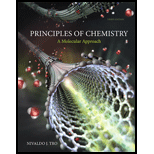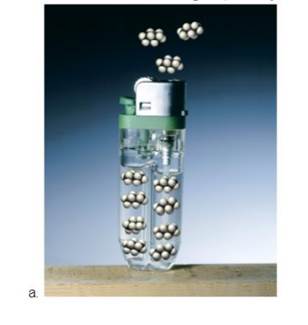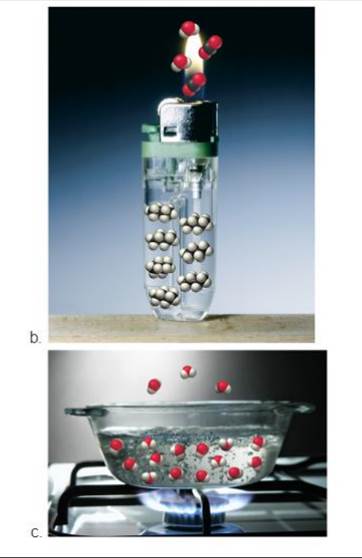
Principles of Chemistry: A Molecular Approach (3rd Edition)
3rd Edition
ISBN: 9780321971944
Author: Nivaldo J. Tro
Publisher: PEARSON
expand_more
expand_more
format_list_bulleted
Concept explainers
Textbook Question
Chapter 1, Problem 18E
Based on the molecular diagram, classify each change as physical or chemical.


Expert Solution & Answer
Want to see the full answer?
Check out a sample textbook solution
Students have asked these similar questions
Describe the mesomeric or resonance effect and differentiate between types +E or +M and -R or -M.
I need help with the following two problems, understanding them in a simple manner. Can you please draw them out for me with a detailed explanation so that I can better comprehend? I'm a visual person, so I definitely need that. Thank you very much!
Problem 54, could you please explain it in detail? Thank you! Step by step, I'm really confused, so please don't make it overly complex. My question is to visually draw it out and demonstrate it to me; I'm confused about that problem, please (not just in words) but demonstrate it to me in all due essence (visually) with descriptions.
Chapter 1 Solutions
Principles of Chemistry: A Molecular Approach (3rd Edition)
Ch. 1 - For Practice 1.1 Is each change physical or...Ch. 1 - Prob. 1.2PCh. 1 - Prob. 1.3PCh. 1 - Prob. 1.3MPCh. 1 - Record the temperature on the thermometer shown...Ch. 1 - For Practice 1.5 How many significant figures are...Ch. 1 - Perform the calculations to the correct number of...Ch. 1 - Prob. 1.7PCh. 1 - Convert 9255 cm3 to gallons.
Ch. 1 - Prob. 1.9P
Ch. 1 - Prob. 1.9MPCh. 1 - Backpackers often use canisters of white gas to...Ch. 1 - Prob. 1.10MPCh. 1 - For Practice 1.11
Find the radius (r)of an...Ch. 1 - Prob. 1.12PCh. 1 - Prob. 1SAQCh. 1 - Q2. This image represent a particulate view of a...Ch. 1 - Prob. 3SAQCh. 1 - Which property of rubbing alcohol is a chemical...Ch. 1 - Prob. 5SAQCh. 1 - Prob. 6SAQCh. 1 - Q7. Determine the mass of a 1.75 L sample of a...Ch. 1 - Prob. 8SAQCh. 1 - Q9. Perform the calculation to the correct number...Ch. 1 - Prob. 10SAQCh. 1 - Prob. 11SAQCh. 1 - Prob. 12SAQCh. 1 - Prob. 13SAQCh. 1 - Prob. 14SAQCh. 1 - Prob. 15SAQCh. 1 - 1. Classify each statement as an observation, a...Ch. 1 - Classify each statement as an observation, a law...Ch. 1 - A chemist decomposes several samples of carbon...Ch. 1 - 4. When astronomers observe distant galaxies, they...Ch. 1 - 5. Classify each substance as a pure substance or...Ch. 1 - 6. Classify each substance as a pure substance or...Ch. 1 - 7. Complete the table.
Substance Pure or...Ch. 1 - 8. Complete the table.
Substance Pure or...Ch. 1 - 9. Determine whether each molecular diagram...Ch. 1 - 10. Determine whether each molecular diagram...Ch. 1 - 11. Several properties of isopropyl alcohol (also...Ch. 1 - 12. Several properties of ozone (a pollutant in...Ch. 1 - 13. Classify each property as physical or chemical...Ch. 1 - 14. Classify each property as physical or...Ch. 1 - 15. Classify each change as physical or...Ch. 1 - 16. Classify each change as physical or chemical....Ch. 1 - 17. Based on the molecular digram, classify each...Ch. 1 - Based on the molecular diagram, classify each...Ch. 1 - 19. Convert each temperature.
a. 32 °F to °C...Ch. 1 - 20. Convert each temperature.
a. 212 °F to °C...Ch. 1 - 21. The coldest temperature ever measured m the...Ch. 1 - 22. The warmest temperature ever measured in the...Ch. 1 - 23. Use the prefix multipliers to express each...Ch. 1 - 24. Use scientific notation to express each...Ch. 1 - Complete the table: a. 1245kg 1.245106 g 1.245109...Ch. 1 - 26. Express the quantity 254,998 m in each unit....Ch. 1 - 27. How many 1 cm squares would it take to...Ch. 1 - 28. How many 1 cm cubes would it take to construct...Ch. 1 - 29. A new penny has a mass of 2.49 g and a volume...Ch. 1 - 30. A titanium bicycle frame displaces 0.314 L of...Ch. 1 - 31. Glycerol is a syrupy liquid often used in...Ch. 1 - 32. A supposedly gold nugget is tested to...Ch. 1 - 33. Ethylene glycol (antifreeze) has a density of...Ch. 1 - 34. Acetone (nail polish remover) Pies a density...Ch. 1 - 35. Read each measurment to the correct number of...Ch. 1 - Read each measurement to the correct number of...Ch. 1 - 37. For each measurement, underline the zeroes...Ch. 1 - 38. For each measurement underline the zeroes that...Ch. 1 - 39. How many significant figures are in each...Ch. 1 - 40. How many significant figures are in each...Ch. 1 - 41. Which quantities are exact numbers and...Ch. 1 - 42. Indicate the number of significant figures in...Ch. 1 - 43. Round each number to four significant...Ch. 1 - 44. Round each number to three significant...Ch. 1 - 45. Perform each calculation to the correct number...Ch. 1 - 46. Perform each calculation to the correct number...Ch. 1 - 47. Perform each calculation to the correct number...Ch. 1 - Prob. 48ECh. 1 - 49. Perform each calculation to the correct number...Ch. 1 - Prob. 50ECh. 1 - 51. A flask containing 117 mL of a liquid weighs...Ch. 1 - 51. A flask containing 11.7 mL of a liquid weighs...Ch. 1 - 53. Perform each unit conversion.
a. 27.8 L to cm3...Ch. 1 - 54. Perform each unit conversion.
a. 28.9 nm to ?m...Ch. 1 - 55. Perform each unit conversion between the...Ch. 1 - 56. Perform each unit conversion between the...Ch. 1 - 57. A runner wants to run 10.0 km at a pace of 7.5...Ch. 1 - 58. A cyclist rides at an average speed of 24...Ch. 1 -
59. A European automobile has a gas mileage of...Ch. 1 -
60. A gas can holds 5.0 gallons of gasoline....Ch. 1 - 61. A modest-sized house has an area of 195m2....Ch. 1 - 62. A bedroom has a volume of 115 m3. What is its...Ch. 1 - Prob. 63ECh. 1 - Total U.S. farmland occupies 954 million acres....Ch. 1 - Prob. 65ECh. 1 - Prob. 66ECh. 1 - Prob. 67ECh. 1 - Prob. 68ECh. 1 - 69. Classify each property as intensive or...Ch. 1 - 70. At what temperatures are the readings on the...Ch. 1 - 71. Suppose you have designed a new thermometer...Ch. 1 - On a new Jekyll temperature scale water freezes at...Ch. 1 - 73. Do each calculation without using your...Ch. 1 - 74. The value of the euro was recently $l.38 U.S....Ch. 1 - Prob. 75ECh. 1 - 76. The proton has a radius of approximately cm...Ch. 1 - Prob. 77ECh. 1 - Prob. 78ECh. 1 - Prob. 79ECh. 1 - Prob. 80ECh. 1 - Prob. 81ECh. 1 - Prob. 82ECh. 1 - The Toyota Prius, a hybrid electric vehicle, has...Ch. 1 - Prob. 84ECh. 1 - Prob. 85ECh. 1 - Prob. 86ECh. 1 - A length of #8 copper wire (radius = 1.63 mm) has...Ch. 1 - Prob. 88ECh. 1 - Prob. 89ECh. 1 - Prob. 90ECh. 1 - Prob. 91ECh. 1 - Prob. 92ECh. 1 - Nanotechnology, the field of building ultra-small...Ch. 1 - Prob. 94ECh. 1 - A box contains a mixture of small copper spheres...Ch. 1 - Prob. 96ECh. 1 - Prob. 97ECh. 1 - Prob. 98ECh. 1 - A cube has an edge length of 7 cm. If it is...Ch. 1 - Prob. 100ECh. 1 - For each box, examine the blocks attached to the...Ch. 1 - Prob. 102E
Knowledge Booster
Learn more about
Need a deep-dive on the concept behind this application? Look no further. Learn more about this topic, chemistry and related others by exploring similar questions and additional content below.Similar questions
- So, the first image is what I'm trying to understand regarding my approach. The second image illustrates my teacher's method, and the third image includes my notes on the concepts behind these types of problems.arrow_forwardHAND DRAWarrow_forwardDraw a mental model for calcium chloride mixed with sodium phosphatearrow_forward
- here is my question (problem number 20) please explain to me thanks!arrow_forwardThe bromination of anisole is an extremely fast reaction. Complete the resonance structures of the intermediate arenium cation for the reaction (Part 1), and then answer the question that follows (Part 2).arrow_forwardDrawing of 3-fluro-2methylphenolarrow_forward
arrow_back_ios
SEE MORE QUESTIONS
arrow_forward_ios
Recommended textbooks for you
- Chemistry: Matter and ChangeChemistryISBN:9780078746376Author:Dinah Zike, Laurel Dingrando, Nicholas Hainen, Cheryl WistromPublisher:Glencoe/McGraw-Hill School Pub Co
 General Chemistry - Standalone book (MindTap Cour...ChemistryISBN:9781305580343Author:Steven D. Gammon, Ebbing, Darrell Ebbing, Steven D., Darrell; Gammon, Darrell Ebbing; Steven D. Gammon, Darrell D.; Gammon, Ebbing; Steven D. Gammon; DarrellPublisher:Cengage Learning
General Chemistry - Standalone book (MindTap Cour...ChemistryISBN:9781305580343Author:Steven D. Gammon, Ebbing, Darrell Ebbing, Steven D., Darrell; Gammon, Darrell Ebbing; Steven D. Gammon, Darrell D.; Gammon, Ebbing; Steven D. Gammon; DarrellPublisher:Cengage Learning Chemistry: The Molecular ScienceChemistryISBN:9781285199047Author:John W. Moore, Conrad L. StanitskiPublisher:Cengage Learning
Chemistry: The Molecular ScienceChemistryISBN:9781285199047Author:John W. Moore, Conrad L. StanitskiPublisher:Cengage Learning  ChemistryChemistryISBN:9781305957404Author:Steven S. Zumdahl, Susan A. Zumdahl, Donald J. DeCostePublisher:Cengage Learning
ChemistryChemistryISBN:9781305957404Author:Steven S. Zumdahl, Susan A. Zumdahl, Donald J. DeCostePublisher:Cengage Learning
 Introductory Chemistry: An Active Learning Approa...ChemistryISBN:9781305079250Author:Mark S. Cracolice, Ed PetersPublisher:Cengage Learning
Introductory Chemistry: An Active Learning Approa...ChemistryISBN:9781305079250Author:Mark S. Cracolice, Ed PetersPublisher:Cengage Learning

Chemistry: Matter and Change
Chemistry
ISBN:9780078746376
Author:Dinah Zike, Laurel Dingrando, Nicholas Hainen, Cheryl Wistrom
Publisher:Glencoe/McGraw-Hill School Pub Co

General Chemistry - Standalone book (MindTap Cour...
Chemistry
ISBN:9781305580343
Author:Steven D. Gammon, Ebbing, Darrell Ebbing, Steven D., Darrell; Gammon, Darrell Ebbing; Steven D. Gammon, Darrell D.; Gammon, Ebbing; Steven D. Gammon; Darrell
Publisher:Cengage Learning

Chemistry: The Molecular Science
Chemistry
ISBN:9781285199047
Author:John W. Moore, Conrad L. Stanitski
Publisher:Cengage Learning

Chemistry
Chemistry
ISBN:9781305957404
Author:Steven S. Zumdahl, Susan A. Zumdahl, Donald J. DeCoste
Publisher:Cengage Learning


Introductory Chemistry: An Active Learning Approa...
Chemistry
ISBN:9781305079250
Author:Mark S. Cracolice, Ed Peters
Publisher:Cengage Learning
Types of Matter: Elements, Compounds and Mixtures; Author: Professor Dave Explains;https://www.youtube.com/watch?v=dggHWvFJ8Xs;License: Standard YouTube License, CC-BY